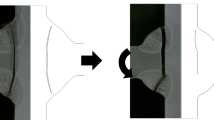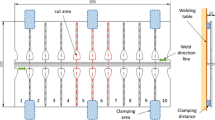Abstract
This study examined the low-cycle fatigue behavior of load-carrying cruciform-welded joints containing incomplete penetration. Five types of specimens with different sizes of weld penetrations and weld leg lengths were tested under cyclic plastic strains. During testing, cracking behavior was observed on the side surface of the specimen. The test results revealed that the fatigue strength and cracking patterns depend on the ratio of the weld penetration to the main plate thickness and the ratio of the weld leg length to the 5main plate thickness, respectively. Elasto-plastic finite element analyses including the effective notch concept were then performed. The results indicate that the fatigue strength and cracking pattern of the specimens can be correlated with the local strain distribution around the effective notch.














Similar content being viewed by others
References
Miki C, Hirabayashi Y (2007) Fatigue damage cases due to inappropriate fabrication in steel bridge structures. Doboku Gakkai Ronbunshuu A, JSCE 63(3):518–532 (in Japanese)
Maddox SJ (1974) Assessing the significance of flaws in welds subject to fatigue. Welding Research Supplement:401s–410s
Gurney TR (1979) Fatigue of welded structure, 2nd edn. Syndics of the Cambridge University Press
Frank KH, Fisher JW (1979) Fatigue strength of fillet welded cruciform joints. Journal of Structural Division, ASCE 105(ST9):1727–1740
Miki C, Tateishi K, Fan H, Tanaka M (1993) Fatigue strengths of fillet-welded joints containing root discontinuities. Int J Fatigue 15(2):133–140
Kainuma S, Mori T, Ichimiya M (2001) Evaluation method for fatigue failure modes in load-carrying fillet welded cruciform joints. Journal of JSCE No.668/I-54:313–318 (in Japanese)
Kainuma S, Mori T (2006) A fatigue strength evaluation method for load-carrying fillet welded cruciform joints. Int J Fatigue 28(8):864–872
Kainuma S, Mori T (2008) A study on fatigue crack initiation point of load-carrying fillet welded cruciform joints. Int J Fatigue 30(9):1669–1677
Ishii Y, Iida K (1969) Low and intermediate cycle fatigue strength of butt welds containing weld defects. Journal of JSNDI 18(10):443–474
Seto A, Masuda T, Machida S, Miki C (1999) Very low cyclic fatigue properties of butt welded joints containing weld defects. Quarterly Journal of the JWS 17(1):130–138 (in Japanese)
Hanji T, Miki C, Saiprasertkit K (2012) Low and high cycle fatigue behaviour of load-carrying cruciform joints containing incomplete penetration and strength mismatch. Welding in the World, IIW 56(5/6):133–146
Saiprasertkit K, Hanji T, Miki C (2012) Fatigue strength assessment of load-carrying cruciform joints with material mismatching in low- and high-cycle fatigue regions based on the effective notch concept. Int J Fatigue 40:120–128
Saiprasertkit K, Hanji T, Miki C (2012) Local strain estimation method for low- and high-cycle fatigue strength evaluation. Int J Fatigue 40:1–6
Saiprasertkit K, Sasaki E, Miki C (2014) Fatigue crack initiation point of load carrying cruciform joints in low and high cycle fatigue regions. Int J Fatigue 59:153–158
ASTM (2013) E140: standard hardness conversion tables for metals relationship among Brinell hardness, Vickers hardness, Rockwell hardness, superficial hardness, Knoop hardness, Scleroscope hardness, and Leeb hardness
Fricke W (2008) Guideline for the fatigue assessment by notch stress analysis for welded structures, IIW Documentation, XIII-2240-08/XV-1289-08,
Acknowledgments
The authors gratefully acknowledge the support of the Japan Welding Engineering Society and would like to express their sincere gratitude to Dr. Tsuyama at KAWADA INDUSTRIES, Inc. and Mr. Takebuchi at MK ENGINEERING, Inc., for fabricating the specimens.
Author information
Authors and Affiliations
Corresponding author
Additional information
Publisher’s note
Springer Nature remains neutral with regard to jurisdictional claims in published maps and institutional affiliations.
Recommended for publication by Commission XIII - Fatigue of Welded Components and Structures
Rights and permissions
About this article
Cite this article
Hanji, T., Tateishi, K., Ohashi, Y. et al. Effect of weld penetration on low-cycle fatigue strength of load-carrying cruciform joints. Weld World 64, 327–334 (2020). https://doi.org/10.1007/s40194-019-00834-w
Received:
Accepted:
Published:
Issue Date:
DOI: https://doi.org/10.1007/s40194-019-00834-w




